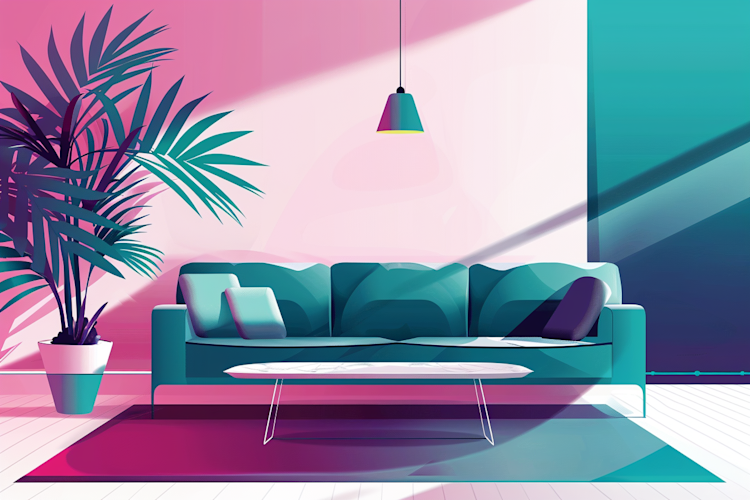From Mid-Century Modern Furniture Design to Cutting-Edge Innovations

Furniture design is an intricate blend of art and science, encompassing various aspects such as aesthetics, ergonomics, and materials. It involves creating functional yet visually pleasing pieces that enhance interior spaces while meeting the practical needs of users. This field intersects with industrial design, interior design, architecture and CAD (Computer-Aided Design), each contributing unique elements to the overall process. From the iconic Wishbone Chair to the luxurious Mario Bellini Sofa, furniture design is a testament to creativity and innovation.
A Brief History of Furniture Design
Furniture design has evolved significantly over centuries, reflecting cultural, technological, and artistic changes. In the mid-20th century, a revolution occurred with the advent of Mid-Century Modern furniture, characterized by clean lines, organic curves, and innovative materials. This period saw the creation of timeless pieces like the Eames Lounge Chair and the Tulip Table, which remain popular today.
Mid-Century Modernism
Mid-Century Modernism emerged post-World War II, emphasizing simplicity and integration with nature. Designers like Charles and Ray Eames and Eero Saarinen revolutionized furniture with their ergonomic and stylish creations. The Eames Lounge Chair, for instance, combined comfort with a sleek design, while the Tulip Table eliminated clutter with its single pedestal base.
Scandinavian Influence
Scandinavian furniture design, known for its minimalism and functionality, gained popularity during the same era. Designers like Arne Jacobsen and Hans Wegner introduced pieces that were not only aesthetically pleasing but also practical. The Wishbone Chair by Wegner, with its elegant curves and natural materials, is a prime example of this design philosophy.
The Role of CAD in Furniture Design
Computer-Aided Design (CAD) has transformed furniture design, enabling designers to create precise models and test various aspects before actual production. CAD allows for intricate detailing, customization, and simulation of real-world conditions, ensuring both functionality and durability.
CAD and Customization
With CAD, designers can easily modify dimensions and features, catering to specific client needs or preferences. This flexibility has led to the creation of personalized pieces like sectional sleeper sofas and modern dining tables that fit perfectly in unique spaces.
Enhancing Precision and Efficiency
CAD software enhances precision in design, reducing errors and material wastage. This efficiency is crucial in modern manufacturing, where sustainability and cost-effectiveness are paramount. For example, creating complex pieces like the Togo Sofa or the Cloud Sofa requires exact measurements and angles, achievable only through advanced CAD tools.
Interior Design and Furniture Selection
Interior design involves selecting furniture that complements the overall aesthetic and functional needs of a space. Key considerations include style, material, color, and ergonomics.
Lounge Room Designs
Designing a lounge room requires a balance of comfort and style. Pieces like the Womb Chair and modern reclining sectionals offer relaxation while contributing to the room's elegance. A well-designed lounge area might feature a blend of mid-century modern chairs and contemporary coffee tables, creating a harmonious yet dynamic space.
Living Hall and Dining Areas
Living hall designs often incorporate versatile furniture that can adapt to different activities. Modern dining tables paired with mid-century modern dining chairs create an inviting dining area, while sectional sofas and modular units provide flexibility for entertainment and relaxation.
Innovative Furniture Designs
Innovation in furniture design is driven by new materials, technologies, and changing lifestyles. Designers constantly explore ways to improve functionality and aesthetics, resulting in groundbreaking pieces.
New Bed and Dressing Table Designs
Modern bed designs, such as those incorporating storage solutions or adjustable features, cater to contemporary living needs. Similarly, dressing table designs now often include integrated lighting and smart storage options, enhancing both usability and style.
Luxury and Outdoor Furniture
Luxury furniture pieces, such as those by Mario Bellini, offer unparalleled comfort and sophistication. For outdoor spaces, luxury outdoor furniture combines durability with style, creating elegant patios and garden areas.
The Future of Furniture Design
The future of furniture design lies in sustainable practices, innovative materials, and smart technology integration. Designers are increasingly focusing on eco-friendly materials and manufacturing processes, while smart furniture, with features like integrated charging stations and adjustable settings, is becoming more prevalent.
Sustainable Practices
Eco-conscious designers are exploring materials like bamboo, reclaimed wood, and recycled metals. These sustainable practices not only reduce environmental impact but also create unique, story-rich pieces.
Smart Technology Integration
Smart furniture is revolutionizing the way we interact with our living spaces. From beds that adjust firmness based on your sleep patterns to tables with built-in wireless charging, technology is enhancing convenience and comfort in furniture design.
Furniture design is a dynamic field that beautifully blends form, function, and innovation. Whether it's the timeless appeal of mid-century modernism or the cutting-edge features of smart furniture, the evolution of this craft continues to inspire and enhance our living spaces.
To explore more about the fascinating world of furniture design and how cutting-edge CAD technology can bring your designs to life, consider signing up for free on our platform. Jinolo offers a comprehensive suite of tools to support your design process, from initial concept to final product, ensuring precision and creativity every step of the way.